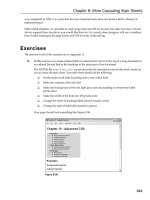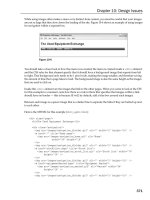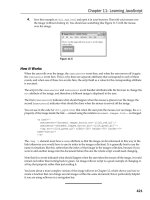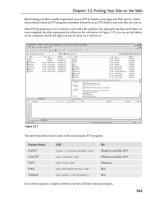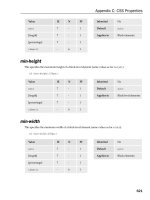learning php mysql javascript and css 2nd edition
Bạn đang xem bản rút gọn của tài liệu. Xem và tải ngay bản đầy đủ của tài liệu tại đây (17.73 MB, 582 trang )
www.it-ebooks.info
www.it-ebooks.info
SECOND EDITION
Learning PHP, MySQL, JavaScript,
and CSS
Robin Nixon
Beijing • Cambridge • Farnham • Kưln • Sebastopol • Tokyo
www.it-ebooks.info
Learning PHP, MySQL, JavaScript, and CSS, Second Edition
by Robin Nixon
Copyright © 2012 Robin Nixon. All rights reserved.
Printed in the United States of America.
Published by O’Reilly Media, Inc., 1005 Gravenstein Highway North, Sebastopol, CA 95472.
O’Reilly books may be purchased for educational, business, or sales promotional use. Online editions
are also available for most titles (). For more information, contact our
corporate/institutional sales department: 800-998-9938 or
Editor: Andy Oram
Production Editor: Iris Febres
Copyeditor: Rachel Head
Proofreader: Kiel Van Horn
August 2012:
Indexer: Ellen Troutman Zaig
Cover Designer: Karen Montgomery
Interior Designer: David Futato
Illustrator: Robert Romano
Second Edition.
Revision History for the Second Edition:
2012-08-10
First release
See for release details.
Nutshell Handbook, the Nutshell Handbook logo, and the O’Reilly logo are registered trademarks of
O’Reilly Media, Inc. Learning PHP, MySQL, JavaScript, and CSS, the image of sugar gliders, and related
trade dress are trademarks of O’Reilly Media, Inc.
Many of the designations used by manufacturers and sellers to distinguish their products are claimed as
trademarks. Where those designations appear in this book, and O’Reilly Media, Inc., was aware of a
trademark claim, the designations have been printed in caps or initial caps.
While every precaution has been taken in the preparation of this book, the publisher and authors assume
no responsibility for errors or omissions, or for damages resulting from the use of the information contained herein.
ISBN: 978-1-449-31926-7
[LSI]
1344626556
www.it-ebooks.info
For Julie
www.it-ebooks.info
www.it-ebooks.info
Table of Contents
Preface . . . . . . . . . . . . . . . . . . . . . . . . . . . . . . . . . . . . . . . . . . . . . . . . . . . . . . . . . . . . . . . . . . . . xvii
1. Introduction to Dynamic Web Content . . . . . . . . . . . . . . . . . . . . . . . . . . . . . . . . . . . . . . 1
HTTP and HTML: Berners-Lee’s Basics
The Request/Response Procedure
The Benefits of PHP, MySQL, JavaScript, and CSS
Using PHP
Using MySQL
Using JavaScript
Using CSS
The Apache Web Server
About Open Source
Bringing It All Together
Test Your Knowledge
2
2
5
5
6
7
9
9
10
10
12
2. Setting Up a Development Server . . . . . . . . . . . . . . . . . . . . . . . . . . . . . . . . . . . . . . . . . 13
What Is a WAMP, MAMP, or LAMP?
Installing a WAMP on Windows
Testing the Installation
Alternative WAMPs
Installing a MAMP on OS X
Configuring MySQL
Testing the Installation
Installing a LAMP on Linux
Working Remotely
Logging In
Using FTP
Using a Program Editor
Using an IDE
Test Your Knowledge
13
14
22
24
24
25
28
31
31
32
32
33
34
36
v
www.it-ebooks.info
3. Introduction to PHP . . . . . . . . . . . . . . . . . . . . . . . . . . . . . . . . . . . . . . . . . . . . . . . . . . . . 37
Incorporating PHP Within HTML
Calling the PHP Parser
This Book’s Examples
The Structure of PHP
Using Comments
Basic Syntax
Understanding Variables
Operators
Variable Assignment
Multiple-Line Commands
Variable Typing
Constants
The Difference Between the echo and print Commands
Functions
Variable Scope
Test Your Knowledge
37
38
39
40
40
41
42
46
49
51
54
54
56
56
57
62
4. Expressions and Control Flow in PHP . . . . . . . . . . . . . . . . . . . . . . . . . . . . . . . . . . . . . . 65
Expressions
Literals and Variables
Operators
Operator Precedence
Associativity
Relational Operators
Conditionals
The if Statement
The else Statement
The elseif Statement
The switch Statement
The ? Operator
Looping
while Loops
do…while Loops
for Loops
Breaking Out of a Loop
The continue Statement
Implicit and Explicit Casting
PHP Dynamic Linking
Dynamic Linking in Action
Test Your Knowledge
vi | Table of Contents
www.it-ebooks.info
65
66
67
68
70
71
75
75
76
78
78
81
82
83
85
85
87
88
89
90
90
91
5. PHP Functions and Objects . . . . . . . . . . . . . . . . . . . . . . . . . . . . . . . . . . . . . . . . . . . . . . 93
PHP Functions
Defining a Function
Returning a Value
Returning an Array
Passing by Reference
Returning Global Variables
Recap of Variable Scope
Including and Requiring Files
The include Statement
Using include_once
Using require and require_once
PHP Version Compatibility
PHP Objects
Terminology
Declaring a Class
Creating an Object
Accessing Objects
Constructors
Writing Methods
Declaring Properties
Declaring Constants
Property and Method Scope in PHP 5
Inheritance
Test Your Knowledge
94
95
96
97
98
99
100
100
100
101
101
102
102
103
104
105
105
108
109
110
111
112
114
117
6. PHP Arrays . . . . . . . . . . . . . . . . . . . . . . . . . . . . . . . . . . . . . . . . . . . . . . . . . . . . . . . . . . . 119
Basic Access
Numerically Indexed Arrays
Associative Arrays
Assignment Using the array Keyword
The foreach...as Loop
Multidimensional Arrays
Using Array Functions
is_array
count
sort
shuffle
explode
extract
compact
reset
end
119
119
121
122
122
124
127
127
127
128
128
128
129
130
131
131
Table of Contents | vii
www.it-ebooks.info
Test Your Knowledge
132
7. Practical PHP . . . . . . . . . . . . . . . . . . . . . . . . . . . . . . . . . . . . . . . . . . . . . . . . . . . . . . . . . 133
Using printf
Precision Setting
String Padding
Using sprintf
Date and Time Functions
Date Constants
Using checkdate
File Handling
Checking Whether a File Exists
Creating a File
Reading from Files
Copying Files
Moving a File
Deleting a File
Updating Files
Locking Files for Multiple Accesses
Reading an Entire File
Uploading Files
System Calls
XHTML
The Benefits of XHTML
XHTML Versions
What’s Different?
HTML 4.01 Document Types
The HTML5 Document Type
XHTML 1.0 Document Types
XHTML Validation
Test Your Knowledge
133
134
136
137
137
140
140
141
141
141
143
143
144
144
145
146
147
148
153
154
155
155
155
156
157
157
158
159
8. Introduction to MySQL . . . . . . . . . . . . . . . . . . . . . . . . . . . . . . . . . . . . . . . . . . . . . . . . . 161
MySQL Basics
Summary of Database Terms
Accessing MySQL via the Command Line
Starting the Command-Line Interface
Using the Command-Line Interface
MySQL Commands
Data Types
Indexes
Creating an Index
Querying a MySQL Database
viii | Table of Contents
www.it-ebooks.info
161
162
162
163
166
168
172
181
182
187
Joining Tables Together
Using Logical Operators
MySQL Functions
Accessing MySQL via phpMyAdmin
Windows Users
OS X Users
Linux Users
Using phpMyAdmin
Test Your Knowledge
196
198
199
199
199
201
201
201
202
9. Mastering MySQL . . . . . . . . . . . . . . . . . . . . . . . . . . . . . . . . . . . . . . . . . . . . . . . . . . . . . 205
Database Design
Primary Keys: The Keys to Relational Databases
Normalization
First Normal Form
Second Normal Form
Third Normal Form
When Not to Use Normalization
Relationships
One-to-One
One-to-Many
Many-to-Many
Databases and Anonymity
Transactions
Transaction Storage Engines
Using BEGIN
Using COMMIT
Using ROLLBACK
Using EXPLAIN
Backing Up and Restoring
Using mysqldump
Creating a Backup File
Restoring from a Backup File
Dumping Data in CSV Format
Planning Your Backups
Test Your Knowledge
205
206
207
208
210
212
214
215
215
216
216
218
218
219
220
220
221
221
223
223
224
226
226
227
227
10. Accessing MySQL Using PHP . . . . . . . . . . . . . . . . . . . . . . . . . . . . . . . . . . . . . . . . . . . . 229
Querying a MySQL Database with PHP
The Process
Creating a Login File
Connecting to MySQL
A Practical Example
229
229
230
231
236
Table of Contents | ix
www.it-ebooks.info
The $_POST Array
Deleting a Record
Displaying the Form
Querying the Database
Running the Program
Practical MySQL
Creating a Table
Describing a Table
Dropping a Table
Adding Data
Retrieving Data
Updating Data
Deleting Data
Using AUTO_INCREMENT
Performing Additional Queries
Preventing SQL Injection
Preventing HTML Injection
Test Your Knowledge
238
239
239
240
241
242
242
243
244
244
245
246
246
247
248
249
252
254
11. Form Handling . . . . . . . . . . . . . . . . . . . . . . . . . . . . . . . . . . . . . . . . . . . . . . . . . . . . . . . 255
Building Forms
Retrieving Submitted Data
register_globals: An Old Solution Hangs On
Default Values
Input Types
Sanitizing Input
An Example Program
Test Your Knowledge
255
256
258
258
259
266
267
270
12. Cookies, Sessions, and Authentication . . . . . . . . . . . . . . . . . . . . . . . . . . . . . . . . . . . . 271
Using Cookies in PHP
Setting a Cookie
Accessing a Cookie
Destroying a Cookie
HTTP Authentication
Storing Usernames and Passwords
Salting
Using Sessions
Starting a Session
Ending a Session
Session Security
Test Your Knowledge
x | Table of Contents
www.it-ebooks.info
271
273
273
274
274
277
277
281
281
284
286
289
13. Exploring JavaScript . . . . . . . . . . . . . . . . . . . . . . . . . . . . . . . . . . . . . . . . . . . . . . . . . . . 291
JavaScript and HTML Text
Using Scripts Within a Document Head
Older and Nonstandard Browsers
Including JavaScript Files
Debugging JavaScript Errors
Using Comments
Semicolons
Variables
String Variables
Numeric Variables
Arrays
Operators
Arithmetic Operators
Assignment Operators
Comparison Operators
Logical Operators
Variable Incrementing and Decrementing
String Concatenation
Escaping Characters
Variable Typing
Functions
Global Variables
Local Variables
The Document Object Model (DOM)
But It’s Not That Simple
Using the DOM
Test Your Knowledge
291
293
293
294
295
297
297
298
298
298
299
299
300
300
301
301
301
302
302
303
303
304
304
305
307
308
309
14. Expressions and Control Flow in JavaScript . . . . . . . . . . . . . . . . . . . . . . . . . . . . . . . . 311
Expressions
Literals and Variables
Operators
Operator Precedence
Associativity
Relational Operators
The with Statement
Using onerror
Using try...catch
Conditionals
The if Statement
The switch statement
The ? Operator
311
312
313
314
314
315
318
318
319
320
320
321
323
Table of Contents | xi
www.it-ebooks.info
Looping
while Loops
do…while Loops
for Loops
Breaking Out of a Loop
The continue Statement
Explicit Casting
Test Your Knowledge
323
323
324
324
325
326
327
327
15. JavaScript Functions, Objects, and Arrays . . . . . . . . . . . . . . . . . . . . . . . . . . . . . . . . . 329
JavaScript Functions
Defining a Function
Returning a Value
Returning an Array
JavaScript Objects
Declaring a Class
Creating an Object
Accessing Objects
The prototype Keyword
JavaScript Arrays
Numeric Arrays
Associative Arrays
Multidimensional Arrays
Using Array Methods
Test Your Knowledge
329
329
331
333
333
333
335
335
336
338
338
339
340
341
345
16. JavaScript and PHP Validation and Error Handling . . . . . . . . . . . . . . . . . . . . . . . . . . 347
Validating User Input with JavaScript
The validate.html Document (Part One)
The validate.html Document (Part Two)
Regular Expressions
Matching Through Metacharacters
Fuzzy Character Matching
Grouping Through Parentheses
Character Classes
Some More Complicated Examples
Summary of Metacharacters
General Modifiers
Using Regular Expressions in JavaScript
Using Regular Expressions in PHP
Redisplaying a Form After PHP Validation
Test Your Knowledge
xii | Table of Contents
www.it-ebooks.info
347
348
350
353
353
354
355
355
356
359
360
361
361
362
367
17. Using Ajax . . . . . . . . . . . . . . . . . . . . . . . . . . . . . . . . . . . . . . . . . . . . . . . . . . . . . . . . . . . 369
What Is Ajax?
Using XMLHttpRequest
Implementing Ajax via POST Requests
The readyState Property
The Server Half of the Ajax Process
Using GET Instead of POST
Sending XML Requests
About XML
Why Use XML?
Using Frameworks for Ajax
Test Your Knowledge
369
370
372
374
375
377
379
381
383
383
383
18. Introduction to CSS . . . . . . . . . . . . . . . . . . . . . . . . . . . . . . . . . . . . . . . . . . . . . . . . . . . . 385
Importing a Style Sheet
Importing a Style Sheet from Within HTML
Embedded Style Settings
Using IDs
Using Classes
CSS Rules
Using Semicolons
Multiple Assignments
Using Comments
Style Types
Default Styles
User Styles
External Style Sheets
Internal Styles
Inline Styles
CSS Selectors
The Type Selector
The Descendant Selector
The Child Selector
The Adjacent Sibling Selector
The ID Selector
The Class Selector
The Attribute Selector
The Universal Selector
Selecting by Group
The CSS Cascade
Style Sheet Creators
Style Sheet Methods
Style Sheet Selectors
386
386
387
387
387
388
388
388
389
390
390
390
390
391
391
392
392
392
393
394
395
395
396
396
397
398
398
398
399
Table of Contents | xiii
www.it-ebooks.info
The Difference Between <div> and <span>
Measurements
Fonts and Typography
font-family
font-style
font-size
font-weight
Managing Text Styles
Decoration
Spacing
Alignment
Transformation
Indenting
CSS Colors
Short Color Strings
Gradients
Positioning Elements
Absolute Positioning
Relative Positioning
Fixed Positioning
Comparing Positioning Types
Pseudoclasses
Pseudoelements
Shorthand Rules
The Box Model and Layout
Setting Margins
Applying Borders
Adjusting Padding
Object Contents
Test Your Knowledge
401
402
404
404
405
406
406
407
407
407
408
408
408
408
409
410
411
411
412
412
412
413
415
416
416
417
418
419
420
421
19. Advanced CSS with CSS3 . . . . . . . . . . . . . . . . . . . . . . . . . . . . . . . . . . . . . . . . . . . . . . . 423
Attribute Selectors
Matching Parts of Strings
The box-sizing Property
CSS3 Backgrounds
The background-clip Property
The background-origin Property
The background-size Property
Multiple Backgrounds
CSS3 Borders
The border-color Property
The border-radius Property
xiv | Table of Contents
www.it-ebooks.info
423
424
425
425
426
426
428
428
430
430
431
Box Shadows
Element Overflow
Multicolumn Layout
Colors and Opacity
HSL Colors
HSLA Colors
RGB Colors
RGBA Colors
The opacity Property
Text Effects
The text-shadow Property
The text-overflow Property
The word-wrap Property
Web Fonts
Google Web Fonts
Transformations
Transitions
Properties to Transition
Transition Duration
Transition Delay
Transition Timing
Shorthand Syntax
Test Your Knowledge
434
435
435
436
437
437
438
438
438
439
439
439
440
440
441
441
444
444
444
444
445
445
447
20. Accessing CSS from JavaScript . . . . . . . . . . . . . . . . . . . . . . . . . . . . . . . . . . . . . . . . . . . 449
Revisiting the getElementById Function
The O Function
The S Function
The C Function
Including the Functions
Accessing CSS Properties from JavaScript
Some Common Properties
Other Properties
Inline JavaScript
The this Keyword
Attaching Events to Objects in a Script
Attaching to Other Events
Adding New Elements
Removing Elements
Alternatives to Adding and Removing Elements
Using Interrupts
Using setTimeout
Canceling a Timeout
449
449
450
451
452
453
453
455
456
457
457
458
459
460
461
462
462
463
Table of Contents | xv
www.it-ebooks.info
Using setInterval
Using Interrupts for Animation
Test Your Knowledge
463
465
467
21. Bringing It All Together . . . . . . . . . . . . . . . . . . . . . . . . . . . . . . . . . . . . . . . . . . . . . . . . 469
Designing a Social Networking Site
On the Website
functions.php
The Functions
header.php
setup.php
index.php
signup.php
Checking for Username Availability
checkuser.php
login.php
profile.php
Adding the “About Me” Text
Adding a Profile Image
Processing the Image
Displaying the Current Profile
members.php
Viewing a User’s Profile
Adding and Dropping Friends
Listing All Members
friends.php
messages.php
logout.php
styles.css
469
470
470
470
472
474
475
475
476
478
479
481
482
482
482
483
485
486
486
486
488
491
493
495
A. Solutions to the Chapter Questions . . . . . . . . . . . . . . . . . . . . . . . . . . . . . . . . . . . . . . 499
B. Online Resources . . . . . . . . . . . . . . . . . . . . . . . . . . . . . . . . . . . . . . . . . . . . . . . . . . . . . 513
C. MySQL’s FULLTEXT Stopwords . . . . . . . . . . . . . . . . . . . . . . . . . . . . . . . . . . . . . . . . . . . 517
D. MySQL Functions . . . . . . . . . . . . . . . . . . . . . . . . . . . . . . . . . . . . . . . . . . . . . . . . . . . . . . 521
Index . . . . . . . . . . . . . . . . . . . . . . . . . . . . . . . . . . . . . . . . . . . . . . . . . . . . . . . . . . . . . . . . . . . . . 533
xvi | Table of Contents
www.it-ebooks.info
Preface
The combination of PHP and MySQL is the most convenient approach to dynamic,
database-driven web design, holding its own in the face of challenges from integrated
frameworks—such as Ruby on Rails—that are harder to learn. Due to its open source
roots (unlike the competing Microsoft .NET framework), it is free to implement and is
therefore an extremely popular option for web development.
Any would-be developer on a Unix/Linux or even a Windows/Apache platform will
need to master these technologies. At the same time, JavaScript is important, as it provides in-browser dynamic functionality and, through Ajax, hidden communication
with the web server to create seamless interfaces. In conjunction with CSS, these technologies integrate to provide a formidable array of powerful web-development tools.
Audience
This book is for people who wish to learn how to create effective and dynamic websites.
This may include webmasters or graphic designers who are already creating static websites but wish to take their skills to the next level, as well as high school and college
students, recent graduates, and self-taught individuals.
In fact, anyone ready to learn the fundamentals behind the Web 2.0 technology known
as Ajax will obtain a thorough grounding in all of these core technologies: PHP, MySQL,
JavaScript, and CSS.
Assumptions This Book Makes
This book assumes that you have a basic understanding of HTML and can at least put
together a simple, static website, but it does not assume that you have any prior knowledge of PHP, MySQL, JavaScript, or CSS. That said, if you do, your progress through
the book will be even quicker.
xvii
www.it-ebooks.info
Organization of This Book
The chapters in this book are written in a specific order, first introducing all of the core
technologies it covers and then walking you through their installation on a web development server, so that you will be ready to work through the examples.
In the following section, you will gain a grounding in the PHP programming language,
covering the basics of syntax, arrays, functions, and object-oriented programming.
Then, with PHP under your belt, you will move on to an introduction to the MySQL
database system, where you will learn everything from how MySQL databases are
structured up to how to generate complex queries.
After that, you will learn how you can combine PHP and MySQL to start creating your
own dynamic web pages by integrating forms and other HTML features. You will then
spend some time looking at ways to speed up your web development using Smarty
templates.
In the next three chapters you will get down to the nitty-gritty practical aspects of PHP
and MySQL development, learning about a variety of useful functions, how to manage
cookies and sessions, and how to maintain a high level of security.
In the following four chapters you will gain a thorough grounding in JavaScript, from
simple functions and event handling to accessing the Document Object Model and inbrowser validation and error handling.
With an understanding of all three of these core technologies, you will then learn how
to make behind-the-scenes Ajax calls and turn your websites into highly dynamic
environments.
Finally, you’ll spend two chapters learning all about using CSS to style and lay out your
web pages, and then you’ll put together everything you’ve learned in a complete set of
programs that together constitute a fully working social networking website.
Along the way, you’ll also find plenty of pointers and advice on good programming
practices and tips that could help you find and solve hard-to-detect programming errors. There are also plenty of links to websites containing further details on the topics
covered.
Supporting Books
Once you have learned to develop using PHP, MySQL, and JavaScript you will be ready
to take your skills to the next level using the following reference books:
• Dynamic HTML: The Definitive Reference ( ) by Danny
Goodman (O’Reilly)
• PHP in a Nutshell ( by Paul Hudson (O’Reilly)
• MySQL in a Nutshell ( by Russell Dyer (O’Reilly)
xviii | Preface
www.it-ebooks.info

